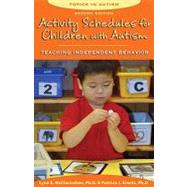Activity Schedules for Children With Autism: Teaching Independent Behavior
, by McClannahan, Lynn E.- ISBN: 9781606130032 | 160613003X
- Cover: Paperback
- Copyright: 7/6/2010
The bestselling guide to creating and using activity schedules - a set of pictures or words that cues a child or adult to engage in a sequence of activities - is newly revised and updated. The benefits of using activity schedules as a teaching tool with people with autism of all ages include getting them to be more self-directed and encouraging them to initiate tasks without supervision, whether during leisure time, in the classroom, or during daily routines at home. This new edition includes more information about how to use these schedules with adults in residential settings and in the workplace, as well as how to make the transition from a photographic or written schedule to a digital device such as an iPod or Blackberry.The second edition also points to new research that shows additional ways this simple but revolutionary tool can help: Activity schedules can decrease problem behaviors during less structured times, increases interactions with peers, and their use helps people with autism to apply what they learned in one situation to another task in a different setting. Schedules also foster the ability to seek attention, leading to more meaningful social connections. Kids with autism learn to ask their parent to look at a picture they've drawn, watch them in an activity, or show a favorite toy to a peer. The authors also describe the advantage of using schedules across all daily activities, not just for isolated tasks, because their use increases the level and length of engagement, the ability to make appropriate choices, to complete tasks, and to go through the day with less supervision. Dozens of real-life anecdotes, photos and charts help to explain techniques, ways to monitor progress, and how to teach different types of skills. This guide will continue to guide thousands of parents and teachers in using this invaluable tool, which brings greater independence to people with autism.







